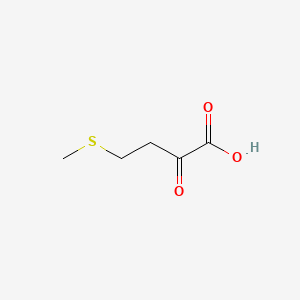| MeSH term | MeSH ID | Detail |
|---|---|---|
| Hemolysis | D006461 | 131 associated lipids |
| Colonic Neoplasms | D003110 | 161 associated lipids |
| Alcoholism | D000437 | 27 associated lipids |
| Neoplasms, Glandular and Epithelial | D009375 | 12 associated lipids |
4-methylthio-2-oxobutanoic acid
4-methylthio-2-oxobutanoic acid is a lipid of Fatty Acyls (FA) class. The involved functions are known as polyamine biosynthetic process, Anabolism, enzyme activity, enzyme pathway and Process. The associated genes with 4-methylthio-2-oxobutanoic acid are 2-keto-4-methylthiobutyric acid, MTAP gene, Homologous Gene, 2-keto-4-thiomethylbutyrate and Alleles. The related lipids are alpha-ketocaproic acid.
Cross Reference
Introduction
To understand associated biological information of 4-methylthio-2-oxobutanoic acid, we collected biological information of abnormalities, associated pathways, cellular/molecular locations, biological functions, related genes/proteins, lipids and common seen animal/experimental models with organized paragraphs from literatures.
What diseases are associated with 4-methylthio-2-oxobutanoic acid?
There are no associated biomedical information in the current reference collection.
Possible diseases from mapped MeSH terms on references
We collected disease MeSH terms mapped to the references associated with 4-methylthio-2-oxobutanoic acid
PubChem Associated disorders and diseases
What pathways are associated with 4-methylthio-2-oxobutanoic acid
There are no associated biomedical information in the current reference collection.
PubChem Biomolecular Interactions and Pathways
Link to PubChem Biomolecular Interactions and PathwaysWhat cellular locations are associated with 4-methylthio-2-oxobutanoic acid?
There are no associated biomedical information in the current reference collection.
What functions are associated with 4-methylthio-2-oxobutanoic acid?
Related references are published most in these journals:
| Function | Cross reference | Weighted score | Related literatures |
|---|
What lipids are associated with 4-methylthio-2-oxobutanoic acid?
Related references are published most in these journals:
| Lipid concept | Cross reference | Weighted score | Related literatures |
|---|
What genes are associated with 4-methylthio-2-oxobutanoic acid?
Related references are published most in these journals:
| Gene | Cross reference | Weighted score | Related literatures |
|---|
What common seen animal models are associated with 4-methylthio-2-oxobutanoic acid?
There are no associated biomedical information in the current reference collection.
NCBI Entrez Crosslinks
All references with 4-methylthio-2-oxobutanoic acid
Download all related citations| Authors | Title | Published | Journal | PubMed Link |
|---|---|---|---|---|
| pmid: | ||||
| Regoli F and Winston GW | Quantification of total oxidant scavenging capacity of antioxidants for peroxynitrite, peroxyl radicals, and hydroxyl radicals. | 1999 | Toxicol. Appl. Pharmacol. | pmid:10198274 |
| Grassmann J et al. | Antioxidant properties of essential oils. Possible explanations for their anti-inflammatory effects. | 2000 | Arzneimittelforschung | pmid:10719616 |
| Amarita F et al. | Lactobacillus casei and Lactobacillus plantarum initiate catabolism of methionine by transamination. | 2001 | J. Appl. Microbiol. | pmid:11412327 |
| Livingstone DR et al. | Increased potential for NAD(P)H-dependent reactive oxygen species production of hepatic subcellular fractions of fish species with in vivo exposure to contaminants. | 2000 Jul-Dec | Mar. Environ. Res. | pmid:11460751 |
| Sekowska A et al. | MtnK, methylthioribose kinase, is a starvation-induced protein in Bacillus subtilis. | 2001 | BMC Microbiol. | pmid:11545674 |
| Amárita F et al. | Conversion of methionine to methional by Lactococcus lactis. | 2001 | FEMS Microbiol. Lett. | pmid:11682200 |
| Kroymann J et al. | A gene controlling variation in Arabidopsis glucosinolate composition is part of the methionine chain elongation pathway. | 2001 | Plant Physiol. | pmid:11706188 |
| Bonnarme P et al. | Sulfur compound production by Geotrichum candidum from L-methionine: importance of the transamination step. | 2001 | FEMS Microbiol. Lett. | pmid:11750811 |
| pmid:12022880 |
